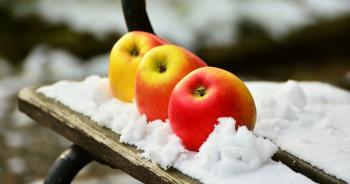Composting in Winter

Excerpt from Bernalillo County Master Composter; shared by John Zarolla, BCMC
When the temperature within a composting setup goes below 55°F, then microbial activity slows down as does the decomposition of organic materials in the bin.
The internal production of heat in any composting setup comes from microbial enzymatic breakdown of the carbohydrates (plants) which have been added. Heat energy from the sun is stored in plants during photosynthesis, which produces carbohydrates. When those plants are decomposed, then energy is released in the form of heat.
Two unique composting methods are the cold process and the hot process. If one is not following the specific guidelines for hot process composting, then all other methods fall into the cold process category.
A cold process composting setup is a frequent choice for home composting. This process is straightforward, easy, and effective. The process may be static; that is, no turning is required if coarse bulking material is added as the pile is built to avoid compaction and facilitate convective air flow. Moisture is maintained in all seasons.
External heat may be added by placing the bin in a sunny location in the colder months. In general, the decomposition process slows in the winter, then speeds up in spring and summer. Though the process is slowed, it is OK to continue to add organics to the bin. When the temperature rises in the spring the materials that have been added will begin to decompose at a faster rate
When you add organics to your bin or soil in the winter, that organic material is in place and ready for faster decomposition as temperatures rise in the spring.
Select a composting process which fits your lifestyle. Continue to organize and recycle your organics in a composting setup in all seasons, including the winter. Maintain moisture in the bin in all seasons. Chop, shred, cut materials before adding to help improve moisture absorption. Add coarse bulking material as the pile is built to reduce compaction and improve convective air flow.
Outdoor worm composting setups will perform well in the urban areas of central New Mexico if the bin is protected from a sustained frost. Insulation may be in the form of straw bales or thick “blankets” of several layers of cardboard. Composting worms, i.e., red wigglers, may be added to a cold process compost bin if the bin is protected from freezing.
For the entire article with additional links, NMSU: Composting in Winter
Mail your questions about winter composting along with your zip code to compost-questions@nmcomposters.org.
